External links
- Extract from p. 32 of the 1972 Fender guitar and bass catalogue, describing the Stringmaster twin and triple neck models then available.
| Fender Stringmaster | |
|---|---|
| Manufacturer | Fender |
| Period | 1953–1980 |
| Construction | |
| Body type | Solid |
| Neck joint | NOT APPLICABLE |
| Scale | 26, 24.5, and 22.5in |
| Woods | |
| Body | Ash |
| Neck | NOT APPLICABLE |
| Hardware | |
| Bridge | Fender One Piece |
| Pickup(s) | 2 proprietary single coils |
| Colors available | |
| Daphne Blue, Dakota Red, Olympic White, Competition Red, Competition Blue, Competition Orange, Sunburst | |
The Fender Stringmaster is a series of console steel guitars produced by Fender from 1953 to 1980.
Models were available with two, three and four necks, each neck with eight strings. The four neck version, known as the quad or Q-8, was discontinued in 1968.
The 1953 MkI models had twin pickups that had stamped Chrome covers with no blend control. The pickups were blended via the tone control; Full off being Bridge Pickup and as the tone control was advanced the Neck pickup was progressively activated. Later the MkII had two single-coil pickups on each neck with black plastic covers, the blend achieved by a small wheel attached to a pot that sat just behind the bridge, introduced in 1954. The bridge pick-up was always on, and the neck pickup could be fed in to taste using the blend pot. Because the pickups were wired with reversed polarities, blending in the neck pickup caused the pickup configuration to be "hum-bucking". Basically the pickup design was a Humbucker split in half and mounted as two interconnected units. A neck selector switch controlled which neck's pickups were 'live'. On earlier 1950s models, the neck selector was controlled originally by slide switches and later by push-buttons. A single tone and a single volume control served the entire instrument.
The original 1953 models had a long scale length, at 26". From 1954 the scale length was reduced, and two shorter lengths were available, 24.5" (31 frets)and 22.5" (29 frets). To determine the guitar's scale count the markers past the 24th fret; there are 2, 3, and 4 markers for the 22.5", 24.5", and 26" guitars respectively.
A single neck version was also available, called the Fender Deluxe, in both six and eight string versions. These guitars are not Stringmasters but use a very similar neck design neck and the same electronics configuration and are often categorized with them. All models of Stringmaster and Deluxe were simply called steel guitars in Fender publications; since the domination of pedal steel guitar non-pedal guitars like the Stringmaster are often referred to as lap steel guitars.
The name Fender Deluxe was a common Fender model name, also used for an unrelated series of Fender combo amplifiers produced from the 1940s to the present day, see Fender Deluxe Reverb.

An electric guitar is a guitar that requires external amplification in order to be heard at typical performance volumes, unlike a standard acoustic guitar. It uses one or more pickups to convert the vibration of its strings into electrical signals, which ultimately are reproduced as sound by loudspeakers. The sound is sometimes shaped or electronically altered to achieve different timbres or tonal qualities on the amplifier settings or the knobs on the guitar from that of an acoustic guitar. Often, this is done through the use of effects such as reverb, distortion and "overdrive"; the latter is considered to be a key element of electric blues guitar music and rock guitar playing.
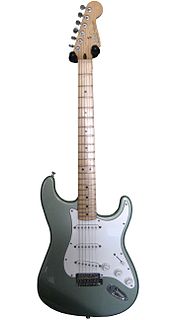
The Fender Stratocaster, colloquially known as the Strat, is a model of electric guitar designed from 1952 into 1954 by Leo Fender, Bill Carson, George Fullerton and Freddie Tavares. The Fender Musical Instruments Corporation has continuously manufactured the Stratocaster since 1954. It is a double-cutaway guitar, with an extended top "horn" shape for balance. Along with the Gibson Les Paul, Gibson SG and Fender Telecaster, it is one of the most-often emulated electric guitar shapes. "Stratocaster" and "Strat" are trademark terms belonging to Fender. Guitars that duplicate the Stratocaster by other manufacturers are sometimes called S-Type or ST-type guitars.
The Fender Jaguar is an electric guitar by Fender Musical Instruments characterized by an offset-waist body, a relatively unusual switching system with two separate circuits for lead and rhythm, and a short-scale 24" neck. Owing some roots to the Jazzmaster, it was introduced in 1962 as Fender's feature-laden top-of-the-line model, designed to lure players from Gibson. During its initial 13-year production run, the Jaguar did not sell as well as the less expensive Stratocaster and Telecaster, and achieved its most noticeable popularity in the surf music scene. After the Jaguar was taken out of production in 1975, vintage Jaguars became popular first with American punk rock players, and then more so during the alternative rock, shoegazing and indie rock movements of the 1980s and 1990s. Fender began making a version in Japan in the mid-1980s, and then introduced a USA-made reissue in 1999. Since then, Fender has made a variety of Jaguars in America, Mexico, Indonesia and China under both the Fender and Squier labels. Original vintage Jaguars sell for many times their original price.
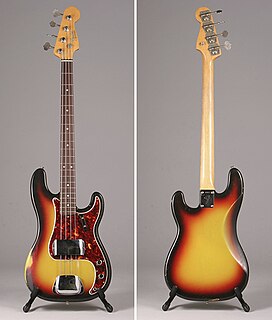
The Fender Precision Bass is a model of electric bass manufactured by Fender Musical Instruments Corporation. In its standard, post-1957 configuration, the Precision Bass is a solid body, four-stringed instrument usually equipped with a single split-coil humbucking pickup and a one-piece, 20-fret maple neck with rosewood or maple fingerboard.
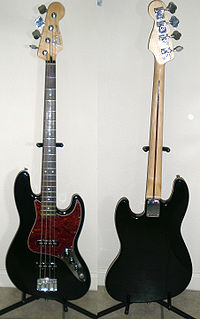
The Fender Jazz Bass is the second model of electric bass created by Leo Fender. It is distinct from the Precision Bass in that its tone is brighter and richer in the midrange and treble with less emphasis on the fundamental frequency. The body shape is also different from the Precision Bass, in that the Precision Bass has a symmetrical lower bout on the body, designed after the Telecaster and Stratocaster lines of guitars, while the Jazz Bass has an offset lower bout, mimicking the design aesthetic of the Jaguar and Jazzmaster guitars.

The Fender Telecaster Deluxe is a solid-body electric guitar originally produced from 1972 to 1981, and re-issued by Fender multiple times starting in 2004.

The Squier '51 is an electric guitar made by Squier, a subsidiary of Fender. The '51 is notable for being one of the few original designs made by Squier, which normally manufactures less expensive authorized copies of Fender's popular guitars and bass guitars.

The Fender Jaguar Bass is an electric bass guitar manufactured in Japan and China by the Fender Musical Instruments Corporation.
A solid-body musical instrument is a string instrument such as a guitar, bass or violin built without its normal sound box and relying on an electromagnetic pickup system to directly detect the vibrations of the strings; these instruments are usually plugged into an instrument amplifier and loudspeaker to be heard. Solid-body instruments are preferred in situations where acoustic feedback may otherwise be a problem and are inherently both less expensive to build and more rugged than acoustic electric instruments.
The Fender Katana is an electric guitar built by Fender. It was designed by marketing director Dan Smith in 1985. The Katana was designed to compete with the unconventionally-shaped guitars of the era, such as the Jackson Randy Rhoads, and to satisfy Fender dealers who were suffering from the competition those instruments offered. The Katana did not sell as well as Fender hoped, and it was discontinued in 1986 before being reissued as a Masterbuilt Custom Shop model as part of the Prestige collection three decades later.
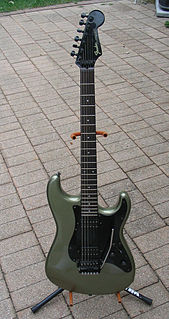
Fender Contemporary Stratocaster electric guitars were produced by Fender Japan in the 1980s.
The Fender Bullet was an electric guitar originally designed by John Page and manufactured and marketed by the Fender Musical Instruments Corporation. It was first introduced as a line of "student" guitars to replace the outgoing Mustang and Musicmaster models.

Duesenberg is a brand for electric string instruments founded in 1986 and located in Hannover, Germany. The headquarter is in Hannover, Germany, they are known for using a Plek machine for the levelling of frets and setup. The actual place for production of guitar bodies and necks have never been revealed by Duesenberg e.g. by showing a factory Tour video.
The White Steel was a steel guitar made by the Fender company. It was released as a student model in 1956 and was sold with the matching amplifier.
The Fender Nashville B-Bender Telecaster is an American Standard series electric guitar made by Fender Musical Instruments Corporation. This guitar is a Fender Telecaster with the addition of a factory-installed B-string bender device. The device raises the pitch of the second (B) string by one whole step to C-sharp. The bend is activated by a one-inch downward pull on the guitar neck, allowing the player to emulate pedal steel sounds and play complex country bends. The Nashville B-Bender Telecaster was introduced in 1996 with major design changes in 1998 and 2000.

Starcaster by Fender' is a range of instruments and accessories aimed at students and beginners, marketed by the Fender Musical Instruments Corporation from the early 2000s until at least 2011. As of April 2018, no products were being marketed under this brand.
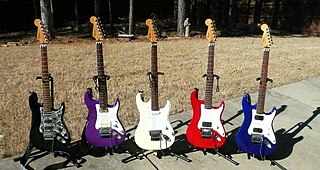
The Squier Stagemaster (discontinued) is a guitar made by Squier, which normally manufactures less expensive authorized copies of Fender's more popular guitars and bass guitars. The Stagemaster is similar in appearance to a Stratocaster with a few cosmetic and functional differences, and is typically classified as a Superstrat. Generally, these differences are:
The Yamaha Corporation is a multinational corporation and conglomerate based in Japan with a wide range of products and services, predominantly musical instruments, motorcycles, power sports equipment and electronics.
The Fender Telecaster, colloquially known as the Tele, is, an electric guitar produced by Fender. Together with its sister model the Esquire, it is the world's first mass-produced, commercially successful solid-body electric guitar. Its simple yet effective design and revolutionary sound broke ground and set trends in electric guitar manufacturing and popular music.
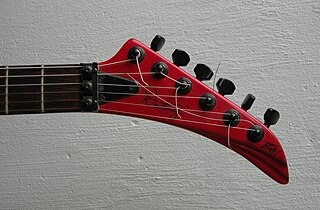
The Peavey Destiny is a solid body electric guitar of the superstrat type, manufactured between 1989 and 1994 in the US by Peavey.